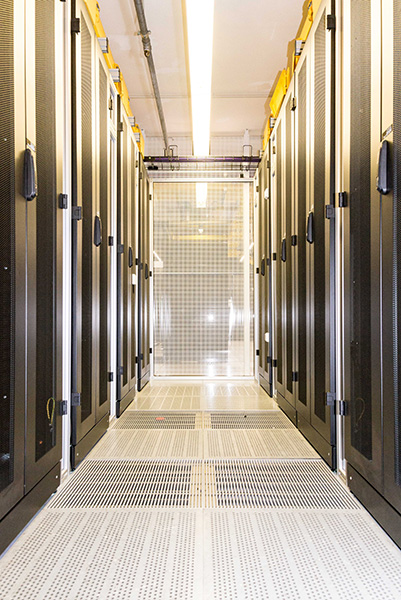Private 5G networks will transform industries thanks to data. Intelligent data processing at the edge and on the cloud will be critical.

By Dr. Thomas King, DE-CIX CTO
By next year, 76% of factories will have deployed a private 5G network, according to an Analysys Mason survey of manufacturers in Germany, Japan, the UK, and the US. It’s not hard to understand why. A private 5G network provides all of 5G’s performance capabilities with the additional benefit of complete control over the network — something manufacturers don’t get with public 5G.
5G is ideal for manufacturing because modern factories rely on data as much as they do electricity. A Capgemini survey found that “75% of manufacturers say 5G is a key enabler of their digital transformation strategy.” For example, industrial robots, automated storage-and-retrieval systems and autonomous material handlers all require a high-bandwidth, ultra-low-latency connection for downloading the big files that detail their tasks. The same link also must support continual uploads such as production data and equipment health.
A fast, reliable data flow enables manufacturers to accommodate demanding customer requirements and industry trends. For example, private 5G on the factory floor provides deep, real-time insights into production and equipment health that are critical in today’s just-in-time manufacturing environment. Suppose a manufacturer of car axles doesn’t know that two of its industrial robots have wrist motors that are starting to overheat. In that case, it won’t be able to shift production to another line or plant before those robots shut down.
Now, the axle manufacturers’ automaker customers will suffer because the steady supply of axles they were counting on will be interrupted. The axle manufacturer will pay a steep price for that disruption, such as contract penalties or even the loss of the contract itself. And if the failing wrist motors aren’t caught early on, they could lead to extensive, expensive damage that puts those robots out of service for days or weeks.
Today, roughly 92% of manufacturers use Wi-Fi on the factory floor, according to the Analysys Mason survey. Most will switch to private 5G because it offers several advantages over Wi-Fi, starting with the licensed spectrum that avoids the crowding that plagues 802.11. That can be a significant problem in environments such as industrial parks with multiple manufacturing tenants next door to one another.
Although Wi-Fi 6 and 6E use the new 6 GHz band, it’s still an unlicensed spectrum. That means there’s still a risk that the manufacturer’s data will have to compete with other nearby users — undermining throughput, latency and reliability.
Another drawback is that a Wi-Fi access point is designed to cover an area of only about 100 square meters. In contrast, a cellular base station can provide reliable broadband speeds for kilometers. As a result, cellular significantly reduces infrastructure costs such as base stations and fiber backhaul when providing connectivity to, for example, an acre of a factory floor or warehouse space.
These factors are why some manufacturers have already started replacing Wi-Fi with private 4G. But now that 5G hardware is widely available and reduced in cost, it makes more sense to use 5G. One reason is that it was designed to meet the unique requirements of Internet of Things (IoT) applications, including factory automation and Industry 4.0. For example, the 5G standards include the following three feature sets:
But to take full advantage of private 5G, manufacturers must develop a strategy for analyzing and acting on the terabytes of data that traverse their networks. This ensures that private 5G enables their digital transformation objectives, such as increased productivity, efficiency, safety, competitiveness and profitability.
Artificial intelligence is essential because it would take a small army of employees to analyze and act on all the data a factory generates just in a single shift. For example, by analyzing data from the sensors on a conveyor motor, AI can determine that vibration or voltage is starting to exceed normal parameters. Then it can alert an employee to investigate. This warning also enables the employee to check to see if a spare motor is in stock and, if not, order one, and prepare to shift production to another conveyor so there’s no downtime during the repair. Without AI, the manufacturer wouldn’t know about the problem until it was too late.
Manufacturers also must develop a strategy for where they deploy AI. This decision depends on the use case. Take the example of a network of surveillance cameras around a factory floor. Some use cases may require local AI, embedded in the cameras, such as detecting jammed conveyor belts, overheating equipment and other problems that require immediate attention.
But with many other use cases, it makes more sense to take advantage of the additional computing power and storage that only the cloud can provide. For example, the surveillance video can also be uploaded to the cloud so the more powerful AI can do deeper analysis. The cloud AI could identify problems that employees on the factory floor might overlook simply because they don’t have the same “big picture” view that AI does. For example, cloud AI could suggest more efficient routes for autonomous material handlers based on production rates. These are just a few ways manufacturers can leverage the combined power of cloud AI and private 5G.
Interconnection is the glue that links AI and the private 5G network, enabling them to work seamlessly to achieve the manufacturer’s digital transformation goals. But this interconnection must be intelligent enough to distinguish different data types and applications. This intelligence enables it to determine which data needs to be processed locally at the edge with extremely low latency to enable rapid response times. Meanwhile, less time-sensitive data can be sent to the cloud for storage and forensic/historical analysis, such as understanding production trends.
IoT is the edge, AI is close to the edge, and 5G serves the edge: The software-defined exchange provides the solution to the future digitalization challenge – the ability to operate and manage future data streams.

Dr. Thomas King has been Chief Technology Officer (CTO) at DE-CIX since 2018, and a Member of the DE-CIX Group AG Board since 2022. Before this, King was Chief Innovation Officer (CIO) at DE-CIX, starting in 2016. He has been instrumental in his role at keeping DE-CIX at the forefront of technological development of Internet Exchanges, establishing DE-CIX as a neutral Cloud Exchange, pushing the boundaries of what is possible in terms of high-bandwidth access technology and security solutions for IX platforms, and trailblazing the automation of IX services with the implementation of patch robots, the development of the DE-CIX API, and overseeing the DE-CIX self-service customer portal.
Scott Ellyson, CEO of East West Manufacturing, brings decades of global manufacturing and supply chain leadership to the conversation. In this episode, he shares practical insights on scaling operations, navigating complexity, and building resilient manufacturing networks in an increasingly connected world.